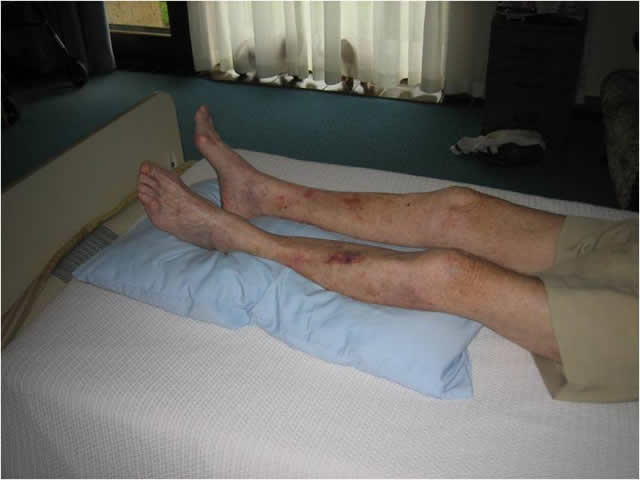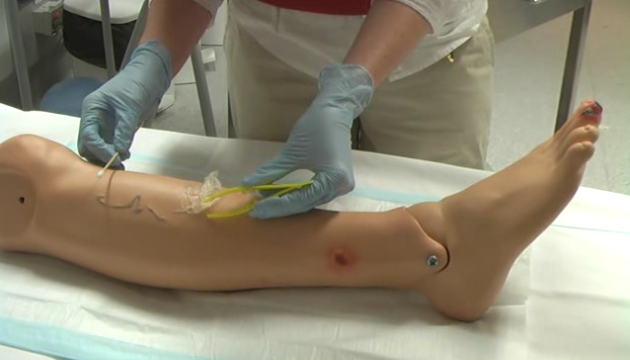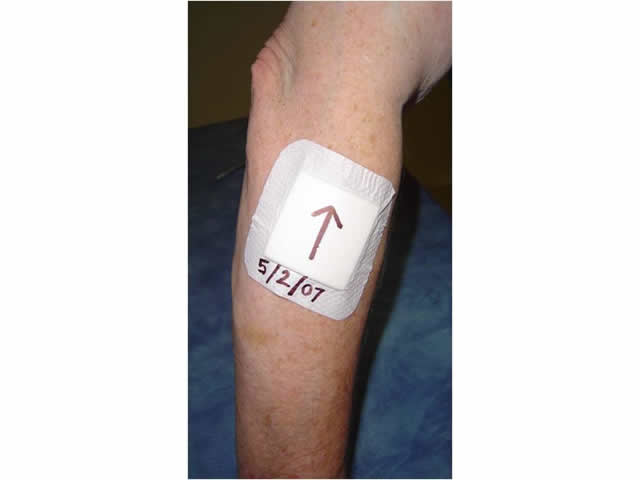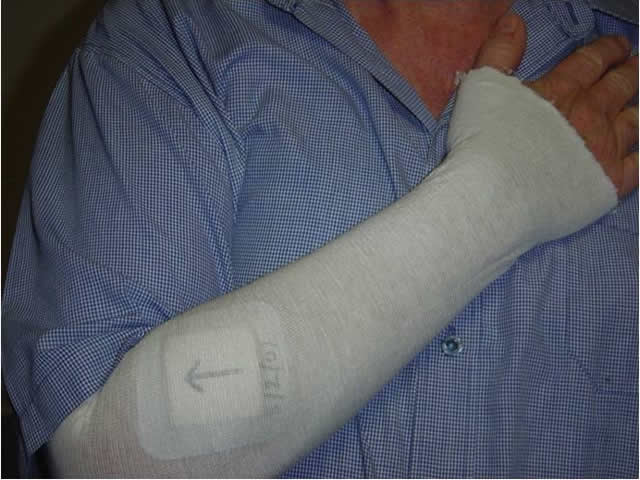Now that you have a better understanding of how to assess a skin tear, you are ready to learn more about the steps to manage a skin tear.
| Step | Explanation |
| 1. Control the bleeding and clean the wound |
- Stop the bleeding by applying firm pressure. Elevate the limb if possible above heart level.
- Clean the wound by gently irrigating with warm normal saline. Carefully clean under the flap to remove foreign debris or blood clots.
- Pat dry the surrounding skin.
IMAGE - M2 07 Leg elevation
|
| 2. Realign (if possible) any skin or flap |
- Gently realign by rolling the skin flap with a moist, sterile cotton bud. The use of a moistened cotton bud assists with approximation of the flap edge.
- Do not stretch the skin to ‘make it fit’. Otherwise, the skin flap will shrink back on itself or it may tear off completely.
- If the skin flap can not be realigned, apply moist wound dressing principles to promote wound healing.
VIDEO - M2_V01 Skin tear management (View video transcript)
|
| 3. Assess the degree of tissue loss and skin or flap colour |
- Using the STAR Skin Tear Classification System, select the skin tear category that best describes the type of skin tear you are treating.
- Note the colour of the skin flap. If the skin or flap colour is pale, dusky or darkened when compared to the person’s normal surrounding skin, this may indicate reduced blood flow (known as “ischaemia”) or the presence of a blood clot (known as “haematoma”), which may affect the skin or flap viability.
- If the skin or flap colour is pale, dusky or darkened reassess in 24 - 48 hours or during the first dressing change.
|
| 4. Assess the surrounding skin condition |
- The condition of the surrounding skin needs to be assessed for fragility, swelling, discolouration and/or bruising. This information will assist you when selecting an appropriate dressing.
|
| 5. Assess the person, their wound and their healing environment |
- A person’s overall medical condition may impact on how quickly the wound is likely to heal. This will guide the management and preventive strategies you decide to use.
|
| 6. Apply a dressing |
Regardless of what type of dressing you select, you should follow these principles:
- Ensure the dressing extends over the wound edge by at least 1.5 - 2 cm. This is to reduce the risk of trauma on removal of the dressing and to increase the ability of the dressing to absorb any leakage from the wound.
- Before applying the dressing, draw arrows on top of the dressing with a felt pen to indicate the direction of the skin flap and date of application. When removing the dressing, ensure that you remove it in the direction of the arrow to avoid pulling back the skin flap.
- Leave in place for 5 - 7 days. Change earlier only if there is 70% leakage on the dressing.
- Reapply a new dressing if healing is not established and leave the dressing intact for 5 - 7 days.
- If the wound is healed, leave it open and moisturise twice daily with a pH neutral emollient.
IMAGE - M2 08 Dressing for skin tear
|
| 7. Protect limbs |
- Apply a limb protector or tubular retention bandage to prevent further damage or to hold any dressing in-situ.
IMAGE - M2 09 Limb protector
|
| 8. Document the skin tear |
- Document the skin tear category and location in the client’s record and wound care assessment chart.
- Submit an incident report as required.
|
| 9. Monitor the healing of the wound |
- Check the dressing and surrounding skin regularly for signs of complications or infection but leave the dressing intact unless an inspection is clinically indicated.
- Educate the client about the signs and symptoms of complications or infection. Advise them to report problems, especially any increase in:
- pain
- warmth
- odour
- redness
- purulent exudate
- fever
|






